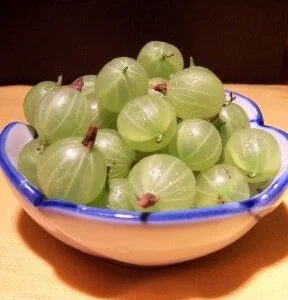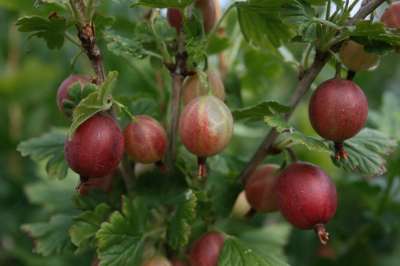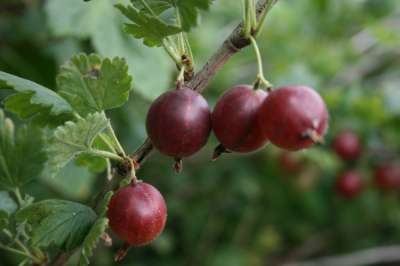Your basket is currently empty!
There’s lots of ideas for growing delicious berries and soft fruits in smaller spaces, no matter what your gardening circumstances you can grow a versatile range of varieties, and it is easy too! Just read on for ideas, practical advice and tips to get the most out of your available space.
Growing Fruit & Berries on the Patio
Most, if not all soft fruit bushes and plants can be grown in containers. The advantage of this is that it is easier to protect the ripening fruits against birds. A wide range of types and varieties can be grown in quite a small space and become a decoratively different feature for balcony, patio or pathway.
Soft fruit bushes such as Gooseberry, Blackcurrant, Redcurrant, and whitecurrant can thrive long term planted individually in containers with a capacity of 12 litres. Blackberries need something a little bigger – 15 litre is sufficient, with a similar size for Loganberries. Strawberries can be grown in wealth of different pots, hanging baskets, grow bags and troughs. Blackcurrant, blackberry and Gooseberry can be grown in a shadier spot if necessary but strawberries, red and whitecurrant really need lots of sun to produce good flavoursome berries.
Blueberries are also particularly good in containers, and most attractive too but make sure you use a lime free compost. They have often been recommended for use in the shrubbery because they look as attractive and beautiful as any ormamental shrub but you get the benefit of lots of delicious berries too.
You will find pruning is not so necessary with any of these fruits when container grown because they won’t produce so much new growth, ideal for hands-off gardeners. Each Autumn go through them and cut out any dead, old or unproductive wood and then the following Spring give a good feed with liquid fertilizer or a light sprinkling of potash to help sustain them through the main growing period.
Regular watering is of course very important especially as the fruits swell, otherwise the berries might be dry or overly pippy. Fruit bushes can stay in these pots for 3-4 years, after that it is a good idea to re-pot in the same size container after having teased out matted roots and shaken out some of the old compost, so you can re-pot with fresh soil. I always recommend using a loam based potting compost, never top soil. The only exception being strawberries which prefer peat based compost.
Keep an eye out for vine weevil as these beetles and their larvae can be especially troublesome with many of the pot grown fruit plants.
Standard Fruit Bushes
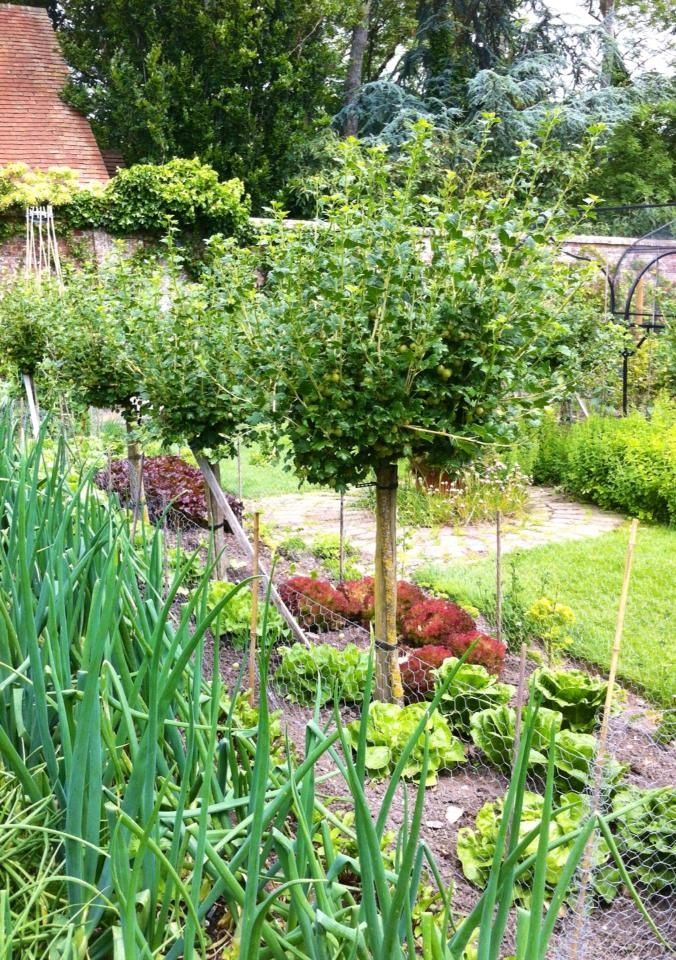
This is a great idea if you don’t have room for a designated fruit growing area and are growing fruit amongst the flowers and in mixed borders as is so often the case these days. The habit is rather like a small standard rose with the fruit bush sitting on top of a clean straight stem, usually grafted at about 100cm’s. Not only do these look more attractive than a normal ground level bush, they are easy to harvest and maintain, and most importantly, you can plant smaller plants such as herbs, annuals or bulbs beneath them so they don’t really take up useful space. Plant them not less than 48” apart, you can also keep then in 10 litre containers if need be to line a pathway or drive. You can grow gooseberry, blackcurrant, red and white currant as standards.
Growing as Cordons
Easy and really popular. If you have a spare fence or wall, or even the room for a couple of posts and wires, then you can grow a great range of gooseberries, redcurrant and whitecurrant as space saving cordons. Cordons have one main stem from which the fruit is borne, or you can grow double cordons in a ‘V’ shape with two main stems. You only need to plant 18” apart for a single cordon and doubles can be planted 24” apart which certainly saves a lot of space when compared to a bush which can be 5-6’ across in maturity. The berries ripen early and evenly as the sunshine is more evenly distributed around the plant. South or west facing walls and fences are ideal but gooseberries can do well on East or even North facing aspects.
Sadly blackcurrants are not really suited to cordon growing.
Berry Plants as Ground Cover
If you have a disused area, even maybe in part shade, as long as the soil is fairly reasonable and can be well cultivated, you can utilize it by growing berries as ground cover. Strawberries, with their travelling runners, do surprisingly well in this informal cultivation technique. You can also use blackberries, which without support will simply romp along. And cranberries, with their low spreading growth are also ideal as well as Tayberries. None of these fruits need full sun to do well.
Soft Fruits in Small Spaces – by Type
Blueberries
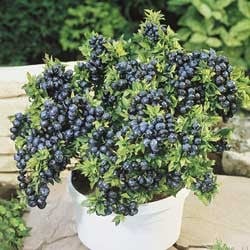
Make use of the patio & grow them in containers. The root system of a Blueberry bush is quite small, often a 10 litre capacity container is sufficient. Make sure you use a proprietary ericaceous compost as the medium must not contain any lime. A full sun position is preferred and pruning is seldom necessary when grown in pots, except to remove any dead older wood. The beautiful bell shaped flowers appear in May and the foliage often turns to brilliant shades in the Autumn – so you can also mix these into the shrubbery or mixed border when the soil is suitable, and they will fit right in! Make sure you give them a good 5’ width space though as growth will be larger than when contained in pots.
Strawberries
Very versatile and easily accommodated, it’s not surprising that these are the most popular fruit plants of all. And with careful selection you can pick plump juicy berries from June to the frosts, as there are lots of varieties that begin cropping at different times. You won’t have to wait long to get your reward either; we recommend planting on summer to get a full crop the next summer following planting. But even if you plant in the Spring, you will usually get some fruits a few weeks later the same summer. Strawberry plants are quite easy growing really so if you requirements are fairly basic then good results can be obtained mixing them into general plantings with herbs etc, you can even grow them beneath shrubs where the soil is fairly good. As for containers, 3 plants will crop happily in a 12” hanging basket. Make sure to be diligent with the watering because as we all know, baskets do dry out rather quickly.
Other containers such as troughs and multiplanters are very suitable. You can also grow them individually in 9” pots for really good full grown plans. Make sure to grow a range of varieties so you harvest the fruits for the longest possible period.
Blackberries
Here two more compact varieties really come to the fore when you’re short on space. These are Waldo and Loch Ness blackberry bushes. Really terrific croppers and quite a bit shorter than more vigorously growing older varieties, the canes will grow 4-6’ only. Waldo in particular can be grown as a shrubby self supporting specimen. Loch Ness is happy on a smaller wall or fence. In either case they can cope with a shady spot too, or grow them as informal ground cover as suggested earlier in this article. Both of these varieties are spine free so a pleasure to grow and pick. You can also grow them in 12 litre capacity containers quite easily but make sure to feed them regularly and generously.
Raspberries – tricky customers for smaller spaces
The Queen of thew soft fruits it has to be said raspberry canes do not lend themselves so well to smaller gardens., Those vigorous canes travel underground and pop up in unsuspecting places, quickly forming spreading colonies and stands. They tend to sulk when grown in containers so I can’t really recommend them for container growing. They also grow tlal – 2 metres even in good soil! There are some rather shorter varieties that can reach only 180cm’s or so, especially if tipped so you can control the height a bit. Malling Jewel, Zeva and Autumn Bliss are recommended, the latter having quite along harvest season which is useful if you are short of space and can only grow one variety. Another tip is to grow these tripod fashion so rather than adhering to the normal 12-15” planting distance, set 3 canes close together and tie them together like a wigwam. You need to be vigilant with the new canes that will pop up in year two – tie them in and take them out if they start to wander.
Gooseberries – not so prickly when treated properly
Gooseberry bushes offer a range of possibilities where space might be at a premium so there’s no excuse not to be enjoying your own gooseberry crumbles, jams and pies in no time at all. The cordon option is very easy to grow and prune, and this is the form I would recommend for first time growers, especially if you have a fence or wall, you can also tie them to a simply post and wire support. They aren’t too particular as to location, some sun is beneficial but not a necessity as long as the situation is fairly open as this will deter mildew. A single cordon has one main stem that can be grown up to 72” or a little less if desired, but remember the longer the stem, the more fruit you will get! A double cordon has two stems in a ‘V’ shape. Plant 18” and 24” apart respectively. You can grow all types this way, from the classic older dessert varieties so sweet you can eat them straight from the bush, and also culinary classics for cooking purposes. I always recommend the mildew resistant cultivars such as Martlet, Greenfinch and Invicta for ease of growth.
The same is true if you decide to grow them as standards [see earlier in this article] grown in the mixed border, and of course you can also grow them happily in 10 litre capacity containers. Use a loam based compost.
Blackcurrants growing idea’s
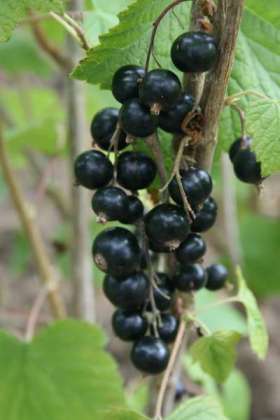
Probably the easiest customers of all the berry fruits, hardy, undemanding as to soil and tolerant of some shade as well as full sun, so these are easy to tuck in anywhere, especially if you grow the compact space saving Scottish variety ‘Ben Sarek’ which has grows seldom more than 100cm’s in height, which is considerably less than others. The fruit quality, yield and flavour are all excellent which is why this is the most popular variety now by far. You could even grow it as a fruiting hedge, plant 24” apart and how about using it to divide the veg and herb garden, or to edge a border or fruit plot.
Blackcurrants also do well in 10 litre containers with a good hearty compost. And they can also be grown as formal standards in the potager, flower border, or kitchen garden.
Redcurrant and whitecurrant
The same botanically, and requiring the same cultivation. Redcurrant bushes are great as single and double cordons grown in the same way as Gooseberries described earlier, but they do prefer a good amount of sun to fruit and ripen well. They are also available as standard with a finished height of about 150cm’s and you may find the value of the vertical is particularly useful to underplant. And they can do well for many years pot grown. The local bird population may be drawn irresistibly to ripening redcurrants so if you can grow them close to the house it may be easier to protect them. Junifer is an excellent early variety and Laxtons no 1 [mid season] and Redstart [late] will cover several weeks and if grown as single cordons need just 54” in length to accommodate the three.
Whitecurrants are seldom so attractive to birds and have a delightful mild, sweet flavour that makes a nice rosy pink jelly and they’re also lovely eaten straight from the bush. They require just the same spacing and cultivation as redcurrants.
Rhubarb
A bit of a beast to grow, an established rhubarb clump can be quite an intimidating space gobbler! If you really want to grow rhubarb, I can’t alas recommend any smaller growers, however it is often planted in some out of the way corner – by the compost heap is a traditional favourite where the rich soil residue can bring about spectacular results. You can also plant in a large bin filled with hearty soil. Rhubarb often goes completely dormant later in summer so you can them move it and put it out the way somewhere until it starts into growth again early the next year.
I hope this article has inspired you to make the most of whatever space you have and shown you that there is really no barrier to growing a wide range of tempting, delicious and varied soft fruits and berries in your garden, patio or even a balcony.




